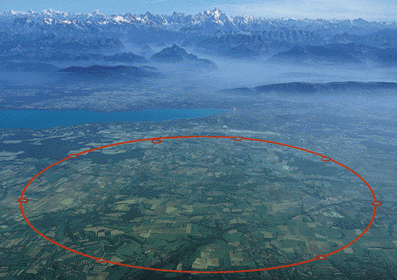
On 27 February 1984 my paper "Particle Masses, Force Constants, and Spin(8)" was received by the International Journal of Theoretical Physics (Int. J. Theor. Phys. 24 (1985) 155-174). It contained the first refereed publication of my calculation of the truth quark mass as 129.5 GeV, using a model that is equivalent to the D4-D5-E6-E7-E8 VoDou Physics model insofar as the truth quark mass is concerned. [ More about the history of my development of the D4-D5-E6-E7-E8 VoDou Physics model can be found here. ]
John Maddox reported in the 12 July 1984 issue of Nature (Nature 310 (12 Jul 84) 97), that a CERN

At the 31 October 1984 Santa Fe meeting of the American Physical Society Division of Particles and Fields, Carlo Rubbia stated that CERN had probably discovered the truth quark at about 40 GeV. At the same meeting, I gave a 10-minute talk about my theoretical work on the truth quark mass, and interpreted the CERN experimental results as being consistent with a truth quark mass of 120 to 160 GeV, rather than 40 GeV.
The CERN announcement of a 40 GeV truth quark mass was generally accepted to the extent that, in 1986, Rabindra Mohapatra, in Section 15.3 of his book "Unification and Supersymmetry, The Frontiers of Quark-Lepton Physics" (Springer-Verlag 1986), discussed the supergravity work of Alvarez-Gaume, Polchinski, and Wise (Nuc. Phys. B221 (1983) 495-523) (similar work was done by Inoue, Kakuto, Komatsu, and Takeshita (Prog. Theor. Phys. 68 (1982) 927) and Ibanez and Lopez (Nuc. Phys. B233 (1984) 511-544)) and stated that:
"It is interesting that [the truth quark mass Mt] lies in the range 100 GeV {= Mt {= 190 GeV. The recent discovery of the t-quark in the mass range of 40-60 GeV therefore rules out the simple-minded analysis carried out here [as in the supergravity work of Alvarez-Gaume et. al.].".
In 1985 I contributed to the Kent Clifford Algebra Meeting at Canterbury, and in 1986 I contributed to the XVI International Colloquium on Group Theoretical Methods in Physics at Drexel University. In my earlier work I had some different weak sector structures, such as 3 generations of weak gauge bosons, uncorrected W0 mass, no Higgs, or a lighter Higgs, that I no longer use in the D4-D5-E6-E7 model.
1987 - ARGUS B-Bbar experiments set limits on the Mass of the Truth Quark, showing it to be between 43 GeV and 180 GeV, and likely to be between 83 GeV and 180 GeV, according to Nir, Nuclear Physics B306 (1988) 14. ARGUS ran at DORIS at DESY during 1982-1992. In his 1997 paper b-Quark Physics at DORIS, presented in Chicago on the occasion of Leon Lederman's 75th birthday, Dietrich Wegener says:
"... B0-B0bar mixing .. is mediated by box diagrams. The mixing parameter rd ... is dominated by virtual t-quark exchange. The experimental situation in 1986 was as ... UA1 claimed [ G. Arnison et al. (UA1), Phys. Lett. B147 (1987) 493 ] a signal at mtop = 40 GeV. As a consequence a small mixing parameter rd = 0.01 was expected. ... In summer 1986, for the first time ARGUS and CLEO had enough statistics ... to search for B0-B0bar mixing. ... At the Berkeley conference the groups presented their limits (90% CL): rd < 0.12 (ARGUS [ H. Albrecht et al. (ARGUS), paper #9717 submitted to Berkeley conference1986. ]) and rd < 0.20 (CLEO [ CLEO, paper submitted to Berkeley conference, CLNS 86{741. ]). Immediately after the conference ARGUS prepared a publication which even got a DESY number (DESY 86-121). However, the distribution of the paper was stopped at the last moment by H.Schroeder. He collected all preprints at the moment they left the printer's offce. All copies were burned! What observation led to this reaction? In August 1986 H. Schroeder started an analysis ... In September 1986, 50 events with a reconstructed B0-B0bar were available to tag the heavy flavor of the B0 ... H. Schroeder presented the first results of his analysis at the ARGUS group meeting September 25, 1986 ... After background subtraction a mixing ratio of rd = 0.20 +/- 0.12 was obtained. The claim that B0-B0bar mixing had indeed been observed was supported by the observation of one fully reconstructed event with 2 B0 mesons in the final state decaying via B0 -> D*+ mu- nu(mu)bar ... The mu- and the K+ both were uniquely identified. The observation of this event is a convincing example of the advantages of the ARGUS detector: precise momentum measurement, good particle identification, and hermeticity. ... This proved the existence of B0-B0bar mixing with a large mixing parameter, totally unexpected at that time. ... To explain the large mixing parameter, ARGUS had to assume the top mass to be large, mtop > 50 GeV, 10 years ago an unconventional assumption in view of the UA1 claim ...".
On 22 May 1992 the paper "ANALYSIS OF TOP-ANTITOP PRODUCTION AND DILEPTON DECAY EVENTS AND THE TOP QUARK MASS" by R. H. Dalitz and Gary R. Goldstein was received by Physics Letters B (Phys. Lett. B 287 (1992) 225-230). It stated that: "A simple idealized procedure is proposed for the analysis of individual top-antitop quark pair production and dilepton decay events, in terms of the top quark mass. This procedure is illustrated by its application to the CDF candidate event. If this event really represents top-antitop production and decay, then the top quark mass would be 131 +22 -11 GeV.".
In the 27 June 1992 issue of the New Scientist, an article by William Bown, titled "TRANSATLANTIC ROW KEEPS TOP QUARK HIDDEN", dealing with analysis of 1988-89 CDF events by Dalitz and Goldstein, stated that:
"... Gary Goldstein, one of Dalitz's collaborators, says he is 'quite confident' that they have discovered the existence and the mass of the quark. ...""... Dalitz and Goldstein were given details of all the collisions by Kris Sliwa, a member of the CDF team ..." "... Alvin Tollestrup, also a member of the [CDF] team, says: 'The two people who are not members of CDF should not have had access to the data.' ..."
[ The possessive attitude of Fermilab and CDF with respect to experimental data they produced (with public USA federal funding) not only produced unconstructive conflict in the Dalitz-Goldstein situation, it also restricted independent analysis of those data and may have suppressed accurate analyses done outside the rigid bonds of Fermilab-CDF consensus. In contrast to the possessive-restrictive attitude of Fermilab-CDF, the WMAP team in 2003 released its basic cosmic microwave data promptly to the public, resulting in outside alternative analyses of the data that showed interesting aspects that were not clearly shown by the in-house consensus analysis. ]
"... If Dalitz turns out to be correct, the $68 million spent on upgrading the Tevatron will have been wasted; and the main credit for finding the particle will go to Dalitz, a scientist outside Fermilab.".
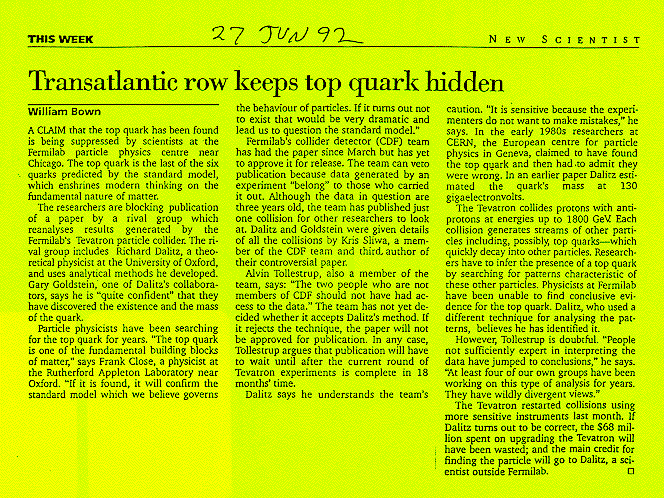
During 13-24 July 1992, I went to The Twentieth Annual SLAC Summer Institute, on The Third Family and the Physics of Flavor. Then my physics model was mostly the same as now, but the Higgs mass was then calculated as about 260 GeV ( close to the 252 GeV that I now calculate to be the Higgs VEV ) rather than my present calculation of the Higgs mass as about 146 GeV. Back then, I was basing my physics model on the Lie Algebra F4 and
The green images above and below are the back and front of a handout that I handed out at the 1992 SLAC Summer Institute ( the white stickers on the front were added later to show how my later D4-D5-E6 formulation compares to my 1992 D4-B4-F4 formulation of my physics model ):
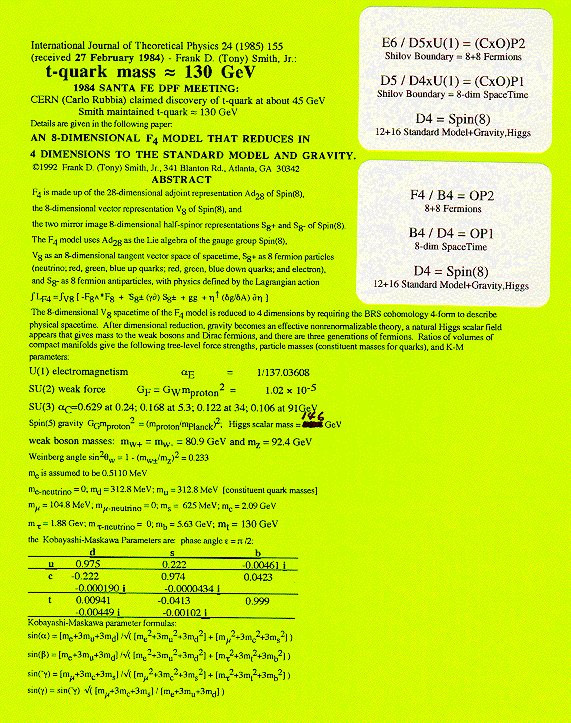
In the 24 July 1992 issue of Science, an article by Faye Flam, titled "RESEARCHERS QUELL QUARK RUMOR: THE TOP IS STILL AT LARGE", stated that:
"... Tollestrup says ... : The CDF researchers demonstrated that all but one of the various events Dalitz's group presented as possible top quarks came from other 'background' effects. One remains ambiguous, but Tollestrup says the CDF people already knew about that event. Goldstein rejects the criticisms. 'It is highly unlikely that the background they have invoked could explain all the events we think are top quark candidates.' ..." "... Goldstein says he sees no problem with working on someone else's unpublished data. He argues that these 3-year-old runs aren't 'hot data'; ... 'If CDF decides our work is not significant enough, the fair thing would be for that data to be published' for the rest of the community to evaluate. ...".
The 15 August 1992 issue of the New Scientist carried a letter from Richard Dalitz, titled "TOP QUARK", saying that:
"With regard to Willian Bown's article ... I did not claim to have found the top quark. That is a job for an experimenter, ... we would never publish data from any group, unless it has given us formal permission to do so or has already published it itself. ... [Bown's] statement in the last paragraph that money spent of the Tevatron up grade would be wasted is opposite to what I said.".
Here is how my physics model looked in 1992.
In August 2000 (5760), the month of the DPF 2000 meeting at Ohio State, I am basing my VoDou Physics model on the Lie Algebra E6 (which can be seen as F4 plus 26-dimensions related to J3(O)o) and
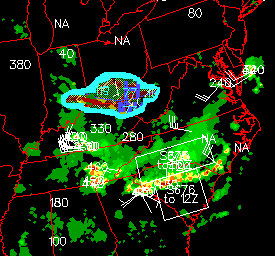
(radar images from Purdue Weather / Unisys)
The ThunderStorm went from Ohio State at 11 A.M. on 9 August 2000 down to Cincinnati by 8 P.M. on 9 August 2000 (the time of the radar in the cyan inset) and then down to to North Georgia by 4:45 A.M. on 10 August 2000 (the time of the wider radar image). I flew from Cincinnati to Atlanta from after 12 midnight on 9/10 August 2000 to after 2 A.M. on 10 August 2000, just to the west of the ThunderStorm, which put on a spectacular Lightning Show through most of the flight. One passenger even saw a red sprite.
In 2002, ten years after the controversial T-quark paper by Dalitz and Goldstein, I had the pleasure of meeting Richard H. Dalitz, Professor of Theoretical Physis, Emeritus, Oxford University. He was speaking at Baylor University in Waco, Texas,
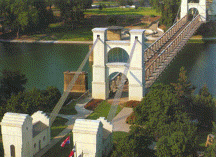
[ The above image is from a Waco Suspension Bridge web page. According to The Handbook of Texas Online, "... The Waco Suspension Bridge is a 475-foot structure that crosses the Brazos River in downtown Waco. At the time that it was built it was one of the longest single-span suspension bridges in the world. In 1866 ... the Waco Bridge Company ... hired Thomas M. Griffith of New York as civil engineer for the project and commissioned the cables and steelwork from John A. Roebling and Son, New York, the company that later built the Brooklyn Bridge. ... The bridge was officially opened on January 7, 1870 ...". On 14 August 2003 an electrical blackout cut off power in an area from Detroit to Cleveland to Toronto to New York City, where people walked across the Brooklyn Bridge to get home from Manhattan. ]
about Paul Dirac, whose lectures he had attended at Cambridge while earning his 1950 Ph.D. degree. I was attending that conference, commemorating the 100th year since Paul Dirac's birth, and was privileged not only to hear Prof. Dalitz's talk, but also to dine with him twice.
......